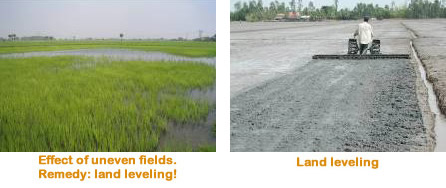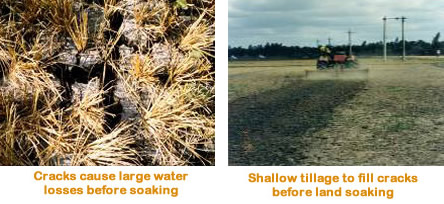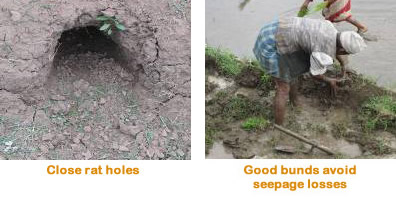Good water management practices
Worldwide, water for agriculture is getting increasingly scarce. By 2025, 15−20 million hectares of irrigated rice may suffer water scarcity. Therefore, well-defined actions must be taken to use water wisely and reduce water losses. Farmers should be introduced to basic principles of good water management for paddy rice.
Field channels
In many paddy fields, water flows from one field to another through breaches in the bunds. Under such conditions, water in an individual field cannot be controlled and therefore, field-specific water management is not possible - construction of channels to convey water to and from each field, or group of fields, greatly improves the irrigation and drainage of water.
Land leveling
 A well-leveled field is seen as laying the foundation for a good water management.
A well-leveled field is seen as laying the foundation for a good water management.
If a field is not properly leveled, water may stagnate in the lower parts whereas higher parts may get dry due to water receding.
This results in uneven crop emergence, uneven early growth, uneven fertilizer distribution, and weed problems. See the fact sheets on land leveling for more information.
Tillage
 Wet land preparation can consume up to one third of the total water used in paddy rice. In large-scale irrigation systems, synchronizing operations and minimizing the duration of the land preparation period can reduce water consumption.
Wet land preparation can consume up to one third of the total water used in paddy rice. In large-scale irrigation systems, synchronizing operations and minimizing the duration of the land preparation period can reduce water consumption.
Large amounts of water can be lost during soaking prior to puddling when large and deep cracks are present. A shallow tillage to fill the cracks before soaking can greatly reduce this water loss.
After soaking, thorough puddling results in a compacted plow sole that reduces water losses by percolation. The efficacy of puddling depends on soil properties. Puddling may not be effective in coarse soils, whereas it is very efficient in clay soils that form cracks during the fallow period. Puddling may not be necessary in heavy clay soils with limited internal drainage. In such soils, direct dry seeding on land that is tilled in a dry state is possible with minimal percolation losses.
Bund
 Good bunds are a prerequisite to limit water losses by seepage and under-bund flows. Bunds should be well compacted and any cracks or rat holes should be plastered with mud at the beginning of the crop season. Also, check for, and repair new rat holes, cracks, and porosity caused by earth worms throughout the growing season. Plastic sheets can be used to repair especially permeable parts of bunds.
Good bunds are a prerequisite to limit water losses by seepage and under-bund flows. Bunds should be well compacted and any cracks or rat holes should be plastered with mud at the beginning of the crop season. Also, check for, and repair new rat holes, cracks, and porosity caused by earth worms throughout the growing season. Plastic sheets can be used to repair especially permeable parts of bunds.
Ponded water depth
Keeping the depth of ponded water around 5 cm minimizes water losses by seepage and percolation. See the fact sheet on Alternate Wetting and Drying for more information on field water management.
Find out more about water management in rice:
Download the book “Water management in irrigated rice - Coping with water scarcity” at: http://books.irri.org/9789712202193_content.pdf